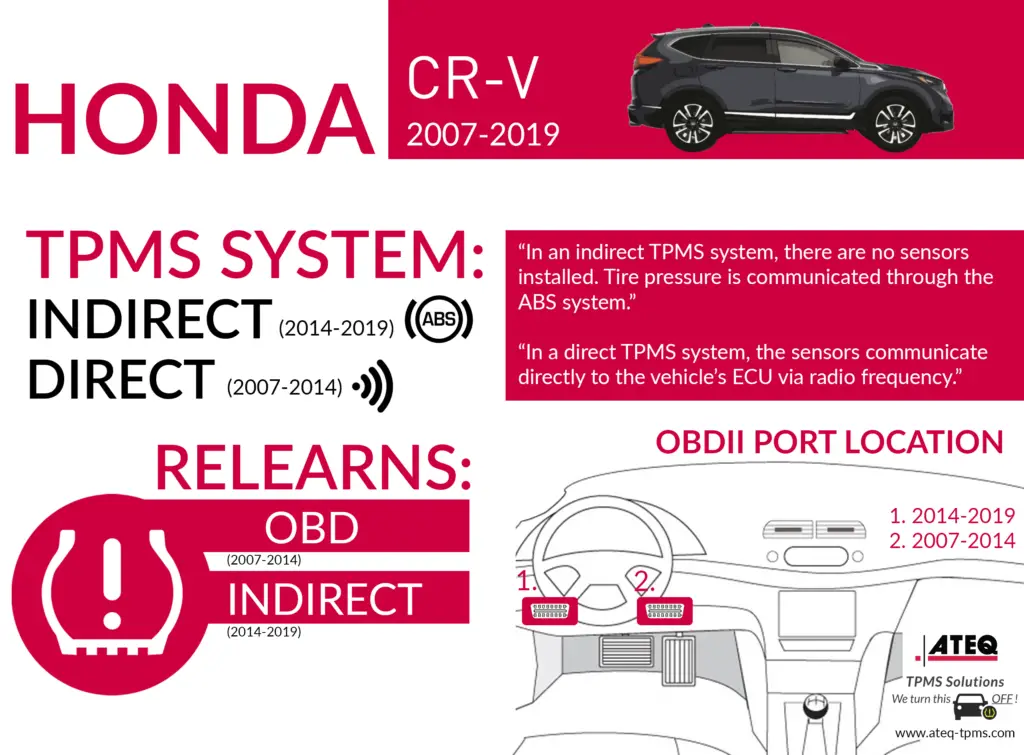TPMS is a requirement in all vehicles in the united states. Honda has been installing the system in all their trims for over a decade. The system undoubtedly aids in letting you know if a tire needs to be inflated. These systems, however, can frequently be annoying.
When the TPMS system in your 2018 Honda CRV is not performing as it should, you need to reset it. This article will walk you through the 2018 Honda CRV tire pressure reset.
2018 Honda CRV Tire Pressure Reset Process
Before starting your tire pressure reset on your Honda CRV, below are some things you should note:
- Your vehicle must be stopped with the transmission in park (CVT, A/T) or neutral (M/T).
- All four tires must be of the same type and size and should be set to the recommended cold inflation pressure.
- The car’s ignition must be turned on.
Below are the steps you can follow to reset your 2018 Honda CRV tire pressure:
- Select vehicle settings using the arrow buttons
- Press the select reset button. This will take you to the TPMS calibration.
- Press the select reset button again. This will take you to the setup screen, where you can select cancel or calibrate.
- Select calibrate using the arrow button.
- Lastly, press the select reset button one more time. You will see a calibration started message.
After twenty minutes of driving, the tire pressure system in your 2018 Honda CRV reset should be complete.
Honda CRV Tire TPMS System 2007-2019 On Graph

Why Your 2018 Honda CRV Tire Pressure Monitoring System Light is On and How to Make It Disappear
Below are some of the reasons why your 2018 Honda CRV TPMS light is on and how to solve each of them:
Low Temperatures
If the temperatures in your area are falling and the tire pressure light is on, the cause could be the temperature differential between when you last set the pressure and the present temperatures. As the temperature drop, the pressure within a tire decreases.
The tires didn’t lose air due to leaks; the pressure decreased as the temperature lowered. This occurs no matter what type of gas is in the tires.
If you discover that your tires’ internal pressure is lower than the desired level, top them off. After adjusting the pressures to the right level, the TPMS light should turn off. Have a tire expert look at your car if just one tire is more than 30% lower than the others.
You Have a Flat or Multiple Flats
A flat tire can be found using the tire pressure monitoring system in your 2018 Honda CRV. This is most likely the cause of the TPMS light while you are driving.
As soon as it’s safe to do so, pull over to a secure location and begin your investigation. A quick visual examination is insufficient. Check the pressure in each of the four tires using a tire gauge.
TPMS System Failure
When a warning light illuminates, our first thought is that it must be an error. Your 2018 Honda CRV TPMS system might have an issue, but it’s improbable.
Yes, everyone who discovers a problem with any vehicle’s tire pressure monitoring system immediately posts about it on all Facebook forums (angrily). The 2018 Honda CRV, however, does not have more TPMS system issues compared to other cars.
Ask a mechanic for assistance if the TPMS system is flashing a warning after you have used a tire gauge to confirm that the pressure in your tires is accurate. You are not required to visit a Honda dealer, although doing so would make sense if your 2018 Honda CRV is still covered by its original new vehicle warranty.
The TPMS system in your 2018 Honda CRV is susceptible to wear and tear, much like any other system. Although individual tire sensors can be changed, the system will still require re-initialization. We advise hiring a mechanic or tire expert familiar with the system and capable of handling the work to complete this task, although you can attempt it using the manual.
Tire Sealants
Slime or Fix-A-Flat emergency tire sealants may make your TPMS sensor inoperable. This doesn’t indicate that the sensor is damaged.
The Fix-A-Flat brand states that its product is TPMS sensor safe in the following manner: your tire should be cleaned with water to remove any sealant that may have come into contact with the TPMS device after the skilled tire repair specialist has fixed your tire. The TPMS system can be reset and will function normally once the repaired tire has been replaced and inflated.
New or New Tires
Check the pressure if you purchase new tires for your 2018 Honda CRV, and the tire pressure warning light comes on immediately.
Errors can occur. And you can have a flat just after driving out of a tire store parking lot. Return to the tire shop and inform them that the 2018 Honda CRV TPMS system has detected a problem if you have examined the pressure and it is set correctly. The system might need to be reinitialized if the tire shop altered the valve stems.
Be warned that some TPMS systems can be affected by the size of the tires. Use the precise tire size that came with your 2018 Honda CRV.
If you select a different size, the store willing to complete the service should be able to demonstrate to you how they will fix the TPMS system issues.
No Nitrogen Needed
Some car dealers and repair facilities advise nitrogen as a fix for a 2018 Honda CRV TPMS issue. The statements made by these supporters of nitrogen tires are unsupported by science.
Your 2018 Honda CRV was also built to operate flawlessly with compressed air. Does the TPMS light turn off when nitrogen is pumped into an underinflated tire? Obviously, it could. Similar to how putting compressed air in the tire will work.
You are free to purchase nitrogen if you so choose. Just be aware that the CRV does not require it.
How to reset low tire light for Tpms for 2017 and 2018 Honda CR-V Ex and above. QUICK AND EASY Way (Must Watch Video)
Frequently Asked Questions (FAQ)
Can You Turn Off the TPMS Light on Your 2018 Honda CRV?
The TPMS light on your 2018 Honda CRV can not be turned off. You can only reset it.
Is it Okay to Drive Your 2018 Honda CRV With the Tire Pressure Light on?
It is unsafe to drive any car with the tire pressure light on until you have confirmed with a tire pressure gauge that the pressure in the tires is correctly set.
When Should You Recalibrate the Tire Pressure System on Your 2018 Honda CRV?
The TPMS system in your 2018 Honda CRV should be recalibrated every time you refill the tire pressure, rotate the tires, or install new tires.
What is the Tire Pressure for a 2018 Honda CRV?
The 2018 Honda CRV comes with 225/65R17 tires. The advised tire pressure for these tires ranges between 35-40psi.
Does 2018 Honda CRV have TPMS sensors?
Yes, Honda CR-V Manufactures direct and indirect TPMS system depends on your car.
Where is the TPMS reset button CR-V?
You will find it Left Of steering wheel .
Final Take
We hope this article helped you understand the steps involved in the 2018 Honda CRV tire pressure reset. You should always rest the TPMS system in your 2018 Honda CRV whenever there is a temperature change, when you switch your tires for newer ones, or when you rotate your car tires. The system should also be reset after refilling your tires.
